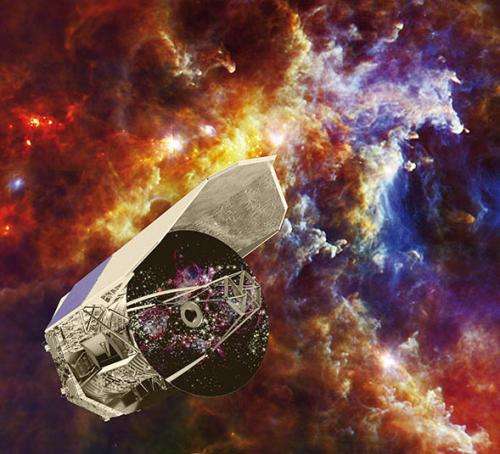A burst of stars 13 billion years ago

(Phys.org) —The universe immediately following the big bang contained mostly hydrogen and some helium. All the other elements needed to make galaxies, planets, and life were formed in stellar interiors or related processes. It is no wonder, then, that the epoch of star formation in the early universe, and the processes at work, are key cosmological questions. Astronomers think that stars started forming in earnest only a few hundred million years after the big bang, but the great bursts of star formation needed to shape the current universe have so far been detected occurring a few billion years later, in galaxies lit up at infrared wavelengths as their dust absorbs light from massive young stars. It has been proposed that similar bursts of activity might actually have happened at earlier times but just gone undetected. They are unnoticed no longer.
Writing in a recent issue of Nature, CfA astronomers Mark Gurwell and Glen Petitpas and a large team of colleagues report finding a galaxy undergoing a massive burst of star formation only about 880 million years after the big bang. The object appears to be making new stars at rate 2000 times faster than does our Milky Way galaxy - or nearly 3000 stars per year. Moreover the temperature of its dust is about three times warmer than Milky Way gas, an additional measure of the dramatic activity underway. In fact, this galaxy seems to be comparable in its activity to most dramatic cases known anywhere, at any cosmic epoch. The scientists spotted it in infrared images from the Herschel Space Observatory, and they determined its distance and epoch by precisely measuring the redshifts of the emission in over a dozen atomic and molecular lines.
Further analysis by the team finds that the galaxy contains over one hundred million solar-masses of warm material, and confirms that the gas is indeed heated by star formation rather than by activity from a massive black hole at its nucleus. The astronomers note that although these stupendous star factories are not all that common in very early times (large numbers of them are not seen in the Herschel images), this one proves for the first time that environments suitable for producing massive starbursts do exist much earlier than had been expected.
Journal information: Nature
Provided by Harvard-Smithsonian Center for Astrophysics



















